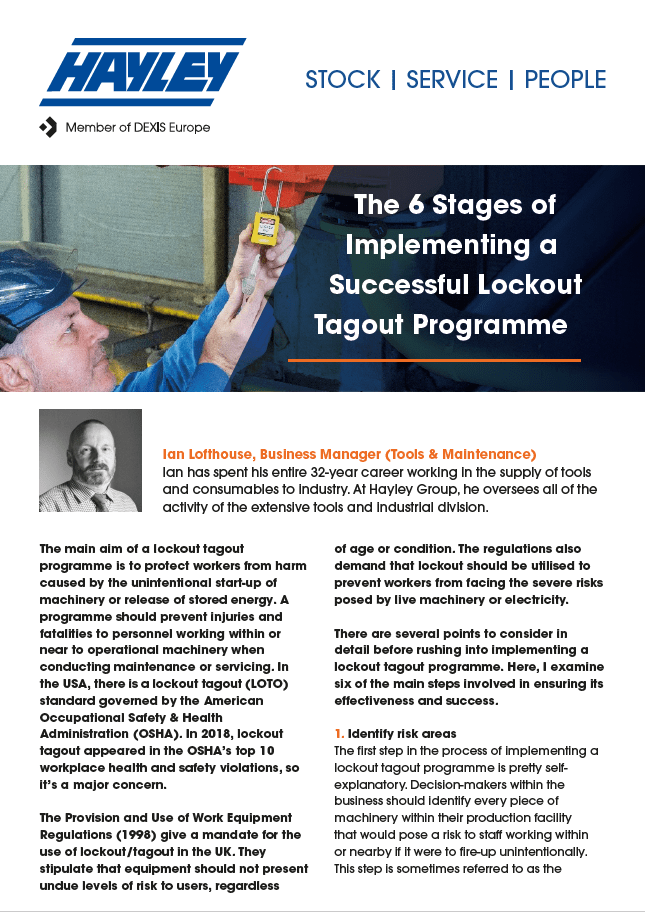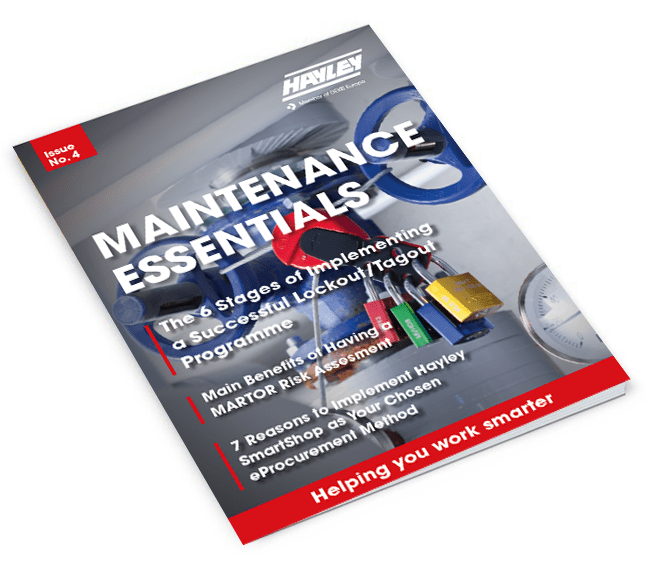by Ian Lofthouse, Business Manager (Tools & Maintenance)
Ian has spent his entire 32-year career working in the supply of tools and consumables to industry. At Hayley Group, he oversees all of the activity of the extensive tools and maintenance product categories.
The main aim of a lockout tagout programme is to protect workers from harm caused by the unintentional start-up of machinery or release of stored energy. A programme should prevent injuries and fatalities to personnel working within or near to operational machinery when conducting maintenance or servicing. In the USA, there is a lockout tagout (LOTO) standard governed by the American Occupational Safety & Health Administration (OSHA). In 2018, lockout tagout appeared in the OSHA’s top 10 workplace health and safety violations, so it’s a major concern.
The Provision and Use of Work Equipment Regulations (1998) give a mandate for the use of lockout/tagout in the UK. They stipulate that equipment should not present undue levels of risk to users, regardless of age or condition. The regulations also demand that lockout should be utilised to prevent workers from facing the severe risks posed by live machinery or electricity. There are several points to consider in detail before rushing into implementing a lockout tagout programme. Here, I examine six of the main steps involved in ensuring its effectiveness and success.
1. Identify risk areas
The first step in the process of implementing a lockout tagout programme is pretty self-explanatory. Decision-makers within the business should identify every piece of machinery within their production facility that would pose a risk to staff working within or nearby if it were to fire-up unintentionally. This step is sometimes referred to as the “equipment appraisal”. As part of the same initial process, all energy control points should be identified, mapped-out, and understood regarding their exact function. All valves, switches, circuit breakers, and plugs need to be acknowledged as points where a label and tag will be required as an essential part of the programme. The appropriate sequencing of isolation also needs to be considered at this stage, along with the noting of any relevant environmental factors such as confined spaces.
2. Drill-down to the specifics
Once businesses have a complete list of their machinery and energy points, a map of where these are, and an understanding of precisely their functions, they will then be in a position to delve deeper into the specifics. All current safety procedures for the use and shutdown of each piece of equipment need to be reviewed and included in the new programme. Using the information collected, machine-specific procedures can be developed, defining the lockout tagout product requirements for each item and workstation/area.
Although businesses may have several machine-specific procedures, as much standardisation as possible should be employed. With consistency and standardisation, familiarity with procedures among the workforce is improved, boosting the entire programme's effectiveness. For example, a standard template for all lockout tagout procedures will make compliance easier to achieve, and will also streamline future training sessions.
3. Develop a strong policy
When confident that specific requirements have been determined correctly, businesses can then move on to the next step. This involves developing and documenting their equipment energy control policy in preparation for implementing an effective lockout tagout programme. A policy should outline all elements of the programme, and include responsibilities, isolation procedures, permits to work, and clear and concise instructions on the use of lockout tagout products and how to return equipment to its regular operation. The creation of a policy should be a collaborative effort involving all levels of the business, as its consequences potentially affect everybody. Once completed, the policy should be formally committed to paper and made available to staff as a key internal document.
Further to the central policy document, a comprehensive set of machine and task-specific guidelines should be drawn-up and displayed at appropriate points around the facility. Such guidelines should detail the shut-down and isolation procedures for the specified equipment, as well as instructions for the placement, removal, and transfer of all lockout tagout devices being used.
4. Fit devices, signage, and guidelines
With the research, requirements gathering, and policy-building completed, it’s at this point where businesses can begin to implement the technologies and items that will help their programme succeed. Sourcing and correctly fitting the most appropriate lockout tagout products for each application is essential to the effectiveness of the programme. Abus is a globally-renowned provider of lockout devices, padlocks, and safety hasps in a broad range of shapes and sizes to fit almost every switch, valve, power outlet, or other hazardous energy point. The products within the extensive Abus lockout tagout range are robust, brightly-coloured, and are recommended for use with their accompanying Abus-manufactured, quality padlocks.
Once lockout devices and tagout products have been fit and tested, they must be stored both safely and conveniently for when they are next needed. The availability of these items must be safeguarded at all times to ensure their use. Applicable signage and the printed instructions for the use of products should also be displayed clearly alongside the relevant equipment.
5. Training and procedure awareness
A new lockout tagout programme requires the workforce to make adjustments to their way of thinking and behaving while carrying out their daily duties. To maximise awareness of a programme, staff must be informed of exactly what it entails, whether or not they happened to be involved in the prior planning stages. Training is vital in reinforcing this understanding among staff, and in developing their ability to optimise their use of lockout tagout products.
6. Audit and review
For any safety programme to be successful and effective in protecting staff from harm, it needs to be perpetually monitored and reviewed. By enforcing procedures over a period of time, and then regularly thereafter, businesses can help to uphold staff awareness of and engagement in a programme. In both the short and long term, this helps to reduce accidents that are costly on both an individual and organisational level.
By auditing the procedures, staff compliance is not the only thing put under the microscope. As with any programme, continuous development and improvement is a must. Regular, structured reviews enable businesses to identify which areas need attention and highlight any new requirements that they may have. They also help to create a culture that proactively addresses safety, rather than simply one that reacts when something goes wrong, saving businesses time and money in the long-term.




